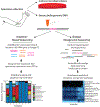Research Techniques Made Simple: Profiling the Skin Microbiota
- PMID: 30904077
- PMCID: PMC7439564
- DOI: 10.1016/j.jid.2019.01.024
Research Techniques Made Simple: Profiling the Skin Microbiota
Abstract
Skin is colonized by microbial communities (microbiota) that participate in immune homeostasis, development and maintenance of barrier function, and protection from pathogens. The past decade has been marked by an increased interest in the skin microbiota and its role in cutaneous health and disease, in part due to advances in next-generation sequencing platforms that enable high-throughput, culture-independent detection of bacteria, fungi, and viruses. Various approaches, including bacterial 16S ribosomal RNA gene sequencing and metagenomic shotgun sequencing, have been applied to profile microbial communities colonizing healthy skin and diseased skin including atopic dermatitis, psoriasis, and acne, among others. Here, we provide an overview of culture-dependent and -independent approaches to profiling the skin microbiota and the types of questions that may be answered by each approach. We additionally highlight important study design considerations, selection of controls, interpretation of results, and limitations and challenges.
Copyright © 2019 The Authors. Published by Elsevier Inc. All rights reserved.
Conflict of interest statement
CONFLICT OF INTEREST
The authors state no conflict of interest.
Figures

References
-
- Chng KR, Tay AS, Li C, Ng AH, Wang J, Suri BK, et al. Whole metagenome profiling reveals skin microbiome-dependent susceptibility to atopic dermatitis flare. Nat Microbiol 2016;1(9):16106. - PubMed
Publication types
MeSH terms
Grants and funding
LinkOut - more resources
Full Text Sources
Miscellaneous

